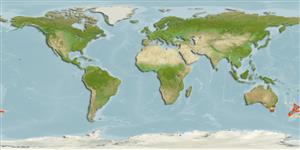Common names from other countries
>
Gadiformes (Cods) >
Moridae (Morid cods)
Etymology: Pseudophycis: Greek, pseudes = false + Greek, phykon = seaweed; because of the habit of living among them (Ref. 45335).
More on author: Forster.
Environment: milieu / climate zone / depth range / distribution range
Ecologia
marinhas; estuarina demersal; intervalo de profundidade 26 - 700 m (Ref. 58489), usually 200 - 300 m (Ref. 54741). Subtropical; 33°S - 50°S, 137°E - 177°E (Ref. 54741)
Southwest Pacific: New Zealand and around Australia, at least from Sydney to Adelaide, and around Tasmania. Often confused with Pseudophycis barbata (Ref.9563).
Length at first maturity / Tamanho / Peso / Idade
Maturity: Lm 52.0, range 45 - 55 cm
Max length : 90.0 cm TL macho/indeterminado; (Ref. 1371); common length : 55.0 cm TL macho/indeterminado; (Ref. 9258)
Espinhos dorsais (total) : 0; Espinhos anais: 0. Nostrils anterior to eye by about one-third of snout length. Pyloric caeca 6 to 8. Color reddish pink becoming paler ventrally, vertical fins with dark margins; a dark black blotch on the pectoral fin base.
Found usually on soft muddy or sandy bottoms. Also on rocky bottoms, in estuaries, bays and continental shelf (Ref. 9563). In New Zealand, most abundant in 200 to 300 m along the edge of the continental shelf. May be found at depths exceeding 700 m (Ref. 9258). Feeds primarily on fishes, cephalopods, crabs and other crustaceans. Utilized as frozen fillets as well as fish blocks; eaten steamed, fried, microwaved and baked (Ref. 9988).
Life cycle and mating behavior
Maturities | Reprodução | Spawnings | Egg(s) | Fecundities | Larvas
Cohen, D.M., T. Inada, T. Iwamoto and N. Scialabba, 1990. FAO species catalogue. Vol. 10. Gadiform fishes of the world (Order Gadiformes). An annotated and illustrated catalogue of cods, hakes, grenadiers and other gadiform fishes known to date. FAO Fish. Synop. 125(10). Rome: FAO. 442 p. (Ref. 1371)
Categoria na Lista Vermelha da IUCN (Ref. 130435)
CITES (Ref. 128078)
Not Evaluated
Ameaça para o homem
Harmless
Utilização humana
Warning: mysqli::__construct(): (HY000/1040): Too many connections in /var/www/html/includes/func_getlabel.php on line 46
Can't connect to MySQL database (fbapp). Errorcode: Too many connections
